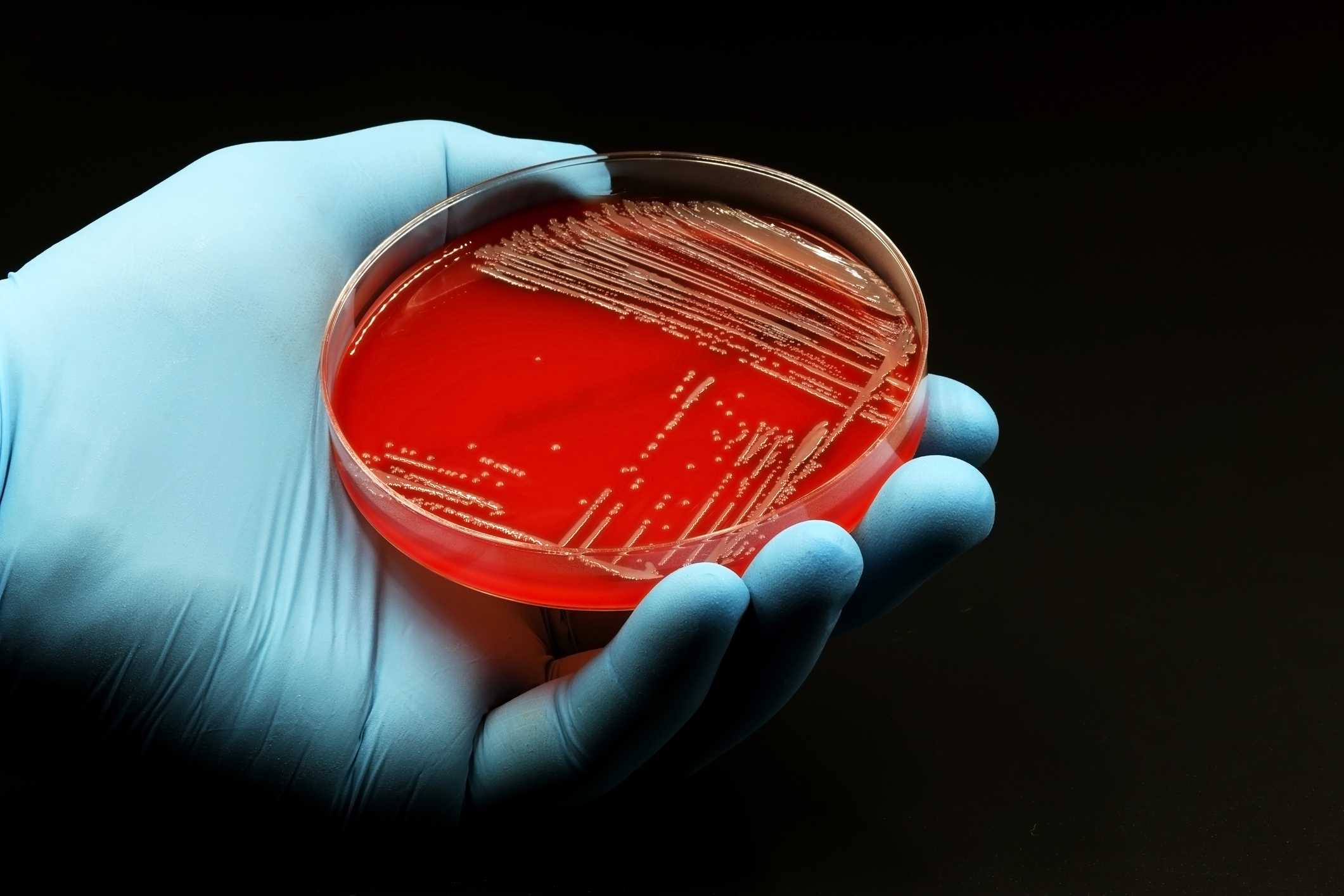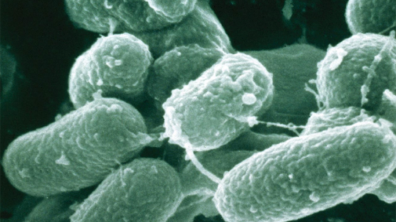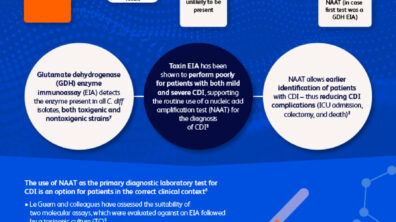
Healthcare-associated infection (HAI) - July 20, 2023
The rise of antimicrobial resistance
Molecular screening techniques for Multi-Drug Resistant Organisms could reduce mortality rates and the economic burden of antimicrobial resistance
Multidrug-resistant organisms (MDROs) are microorganisms, primarily bacteria, that become resistant as a result of antibiotic misuse, as well as through natural mutations.1 Antimicrobial resistance (AMR) is considered to be one of the biggest threats to global health, food security, and development in today’s society.1 AMR not only impedes the treatment of infectious diseases, such as pneumonia, but the World Health Organization (WHO) states “the achievements of modern medicine [are] at risk”, and procedures become far more dangerous without effective antibiotics.”1
A surveillance report released in 2020, based on data for the period 2015-2019, showed European countries had up to 46.7% of invasive isolates of Staphylococcus aureus that were resistant to methicillin (MRSA).2 There are notably high rates of carbapenem-resistant species in some countries including Greece, Italy, and Bulgaria (see table 1).2
Table 1. Percentage of invasive isolates resistant to carbapenems (imipenem or/and meropenem) in Bulgaria, Greece, and Italy.
|
Percentage of invasive isolates resistant to carbapenems (imipenem or/and meropenem)2 |
||||
|
Bulgaria |
Greece |
Italy |
||
|
Acinetobacter species |
≥50% |
≥50% |
≥50% |
|
|
Klebsiella pneumoniae |
25% – <50% |
≥50% |
25% – <50% |
|
|
Pseudomonas aeruginosa |
25% – <50% |
25% – <50% |
10% – <25% |
|
A significant increase in vancomycin-resistant enterococci (VRE) between 2015 and 2019 in a number of European counties was also observed, with Ireland, Germany, Romania, Hungary, Greece, Latvia, Croatia, Lithuania, Poland and Slovakia all having 25–50% of invasive isolates with vancomycin resistance.2 Despite Norway having one of the lowest percentages of AMR in bloodstream infections, resistance to broad-spectrum antibiotics, used to combat MDROs, has increased over the last 10 years.3
The prevalence of MDROs across Europe is increasing, thereby requiring effective intervention to reduce the societal burden. There are several risk factors for the prevalence of MDROs in Europe, some recently emerging, which have a vast impact on European healthcare systems and communities. This adverse impact is likely due to downfalls in current screening techniques, resulting in a lack of AMR detection and control.
Risk Factors for MDROs in Europe
The most notorious risk factor for AMR is antibiotic misuse; globally, a vast amount of antibiotic self-medication occurs due to ‘over the counter’ access. According to the European Centre of Disease Prevention (ECDC) and the WHO, Greece had the highest defined daily dose (DDD) of antibiotic use in Europe and an increase in consumption of 2.4% between 2014 and 2018, while many European countries witnessed a decrease.4 This, accompanied by Greece’s high levels of antibiotic resistance, hints at a causal trend.2
On the other hand, Italy, who had high levels of antibiotic resistance, showed a relatively low DDD suggesting the involvement of additional factors.2,4 New MRSA strains were detected entering Europe in 2021 ; specifically, clone t304/ST6 was identified in five northern European countries as having originated in the Middle East.5 Furthermore, a study of asylum seekers and refugees admitted to Helsinki University Hospital between 2010 and 2017 found that 45% were colonised by MDROs, and 12.5% had two or more detectable MDRO strains.6 The proportion of MDRO carriers were greatest among patients from Iraq (57.2%), Syria (55.8%), Afghanistan (34.8%) and Somalia (25.8%).6
Forced displacement of individuals from low- and middle-income countries in the Middle East and Africa is prevalent in today’s society, with Europe receiving 9.2 million asylum seeking applications between 2010-2019.7 According to the European Commission, Italy and Greece were amongst the European countries with the highest number of first-time asylum-seeking applications.8 Screening for MDROs on arrival into Europe is imperative to reduce the impact on European healthcare systems and communities.
A recent study also found an association between MRSA and climate warming, suggesting a 1°C increase in mean temperature could result in a 1.02-fold increase in MRSA.9 It is suggested that mean warm season temperature was more associated with MRSA resistance, with a correlation coefficient of 0.826.9 Additionally, prevalence of carbapenem-resistant Pseudomonas aeruginosa (CRPA) is estimated to double in the UK and the Netherlands by 2039 and increase by 70% in Denmark due to climate warming alone.9 Another study in the US found that a 10°C increase in temperature across regions elicited an increase of antibiotic resistance of 4.2%, 2.2% and 2.7% in Escherichia coli, Klebsiella pneumoniae and Staphylococcus aureus; this increase was also associated with greater population density suggesting AMR growth should not be underestimated in presently growing populations.10 The appearance of new AMR risk factors will require an increase in faster and more accurate screening methods to prevent continued spread.
Impact of AMR on European countries.
It is suggested that lack of sufficient intervention to combat MDROs could lead to a 72% increase in AMR to second-line antibiotics by 2030 in the EU/EEA; AMR to last-line antibiotics is likely to double.11 This has serious implications for European communities as infections result in increased lengths of hospital stays, increased antimicrobial resistance rates, higher medical costs and increased mortality.12
Where first-line antibiotics can no longer be used, employment of more expensive medications is often necessary, leading to a greater economic burden on families and across society.1 In 2019, AMR and its ineffective treatment cost €1.1b to healthcare systems of EU/EEA countries.11
Worryingly, in 2019, deaths in Europe due to AMR has increased to 33,000.11 A rapid risk assessment for carbapenem-resistant Enterobacteriaceae (CRE) in 2018 suggested that, to avoid delays in treatment and associated mortality, timely and appropriate laboratory investigation and subsequent reporting is essential.14
Culture plating versus molecular screening techniques.
Traditionally, screening for AMR uses culture plating techniques, for which the process from start to finish can take up to five days.15 Waiting this long for identification can lead to delays in implementation of appropriate infection control measures, potentially leading to further transmission and mutation. Moreover, delayed identification can lead to delays in initiating appropriate treatment, which can also contribute to bacterial resistance and could be detrimental to patient health or even prove fatal.
Culture plating also requires a great deal of expertise and laboratory equipment which may limit usage in low- and middle-income countries. Many low- and middle-income European countries, such as Bosnia and Herzegovina, Montenegro, and Albania, have not been assessed for AMR prevalence 2; however Bosnia and Herzegovina had the only statistically significant increase in antibiotic use between 2014 and 2018, at 6%.4 Interestingly, Bulgaria, a middle income country, has a percentage of vancomycin resistance in E. faeciumwas of 18.3% in 2019, which represents a significant increase since 2015 when the percentage was 10.5%.2 This signals a need for greater screening and improved capacity for detecting resistance in such countries to reduce impact on health care systems and communities; yet a need for greater resources and skilled workers makes increasing use of culturing methods implausible.
Research comparing traditional culturing methods with molecular methods, such as quantitative (qPCR) and digital polymerase chain reaction (dPCR), have found culture plate counting significantly underestimates quantification by 257-fold for Mycobacterium.16
Another study found that when specifically comparing methicillin-susceptible S. aureus (MSSA) and MRSA detection using culturing techniques compared to a PCR assay, detection was consistently underestimated. For culturing methods, direct plating detected 22.4% MSSA and 1.2% MRSA in the samples compared to 35.6% MSSA and 2.3% MRSA using the PCR assay.17 In the same study, they modelled these results to national surveillance data and estimated that approximately 5000 to 8000 S. aureus surgical site infections could be prevented by using molecular screening methods. In the UK alone, this could save £17 million to £130 million annually in treatment costs.17
Molecular screening techniques close the gaps in traditional culturing methods
There are several research gaps in the development of an effective MDRO screening product and their implications. Culturing methods are seen to greatly underestimate the number of MDROs within a sample, and such false negatives must be minimised to reduce the impact on healthcare systems. Increasing the number of automated processes to make testing more user-friendly for non-expert staff will be of particular importance in low- to middle-income countries with limited resources and staff training.
Another important factor is the processing time from start to finish. Accurate bacterial detection is returned in minimal time can increase treatment efficacy and recovery time. European statistics on AMR show a clear need for intervention, not only in tackling antibiotic misuse, but in combatting new risk factors, such as forced human displacement and climate warming. Implementation of new molecular testing methods could address this societal burden by greatly reducing the length of hospital visits, limit healthcare costs to both patients and hospitals, reduce further mutation leading to greater resistance, and reduce mortality rates.
References
- World Health Organisation. Antibiotic Resistance. 2020. Available at: https://www.who.int/news-room/fact-sheets/detail/antibiotic-resistance. Accessed: July 2021.
- European Centre for Disease Prevention and Control. Surveillance report. Antimicrobial resistance in the EU/EEA (EARS-Net). 2019. Available at: https://www.ecdc.europa.eu/en/publications-data/surveillance-antimicrobial-resistance-europe-2019. Accessed: July 2021.
- European Centre for Disease Prevention and Control. ECDC country visit to Norway to discuss antimicrobial resistance issues. ECDC. 2019. Available at: https://www.ecdc.europa.eu/sites/default/files/documents/antimicrobial-resistance-country-visit-norway.pdf. Accessed: July 2021.
- Robertson J, Vlahović-Palčevski V, Iwamoto K, Högberg LD, Godman B, Monnet DL, Garner S, Weist K, Strauss R, Vandael E, and Ivanov IN. Variations in the Consumption of Antimicrobial Medicines in the European Region, 2014–2018: Findings and Implications from ESAC-Net and WHO Europe. Front Pharmacol. 2021;12:639207.
- Bartels MD, Worning P, Andersen LP, Bes M, Enger H, Ås CG, Hansen TA, Holzknecht BJ, Larssen KW, Laurent F, and Mäkitalo B. Repeated introduction and spread of the MRSA clone t304/ST6 in northern Europe. Clin Microbiol Infect. 2021;27(2):284.e1-284.e4.
- Aro T and Kantele A. High rates of meticillin-resistant Staphylococcus aureus among asylum seekers and refugees admitted to Helsinki University Hospital, 2010 to 2017. Euro Surveill. 2018;23(45):1700797.
- United Nations High Commissioner for Refugees. Global trends: Forced Displacement in 2019. 2019. Available at: https://www.unhcr.org/5ee200e37.pdf. Accessed: July 2021.
- European Commission. Overall figures of immigrants in European society. 2020. Available at: https://ec.europa.eu/info/strategy/priorities-2019-2024/promoting-our-european-way-life/statistics-migration-europe_en. Accessed: July 2021.
- Kaba HE, Kuhlmann E, and Scheithauer S. Thinking outside the box: association of antimicrobial resistance with climate warming in Europe–a 30 country observational study. Int J Hyg Environ Health. 2020;223(1):151-158.
- MacFadden DR, McGough SF, Fisman D, Santillana M, and Brownstein JS. Antibiotic resistance increases with local temperature. Nat Clim Change. 2018;8(6):510-514.
- European Centre for Disease Prevention and Control. and Organisation for Economic Cooperation and Development. Antimicrobial Resistance: Tackling the Burden in the European Union. 2019; pp.3. Available at: https://www.oecd.org/health/health-systems/AMR-Tackling-the-Burden-in-the-EU-OECD-ECDC-Briefing-Note-2019.pdf. Accessed: July 2021.
- Váradi L, Luo JL, Hibbs DE, Perry JD, Anderson RJ, Orenga S, and Groundwater PW. Methods for the detection and identification of pathogenic bacteria: past, present, and future. Chem Soc Rev. 2017;46(16):4818-4832.
- European Centre for Disease Prevention and Control and the European Medicines Agency. The bacterial challenge: time to react. A call to narrow the gap between multidrug-resistant bacteria in the EU and the development of new antibacterial agents. Available at: https://www.ecdc.europa.eu/sites/portal/files/media/en/publications/Publications/0909_TER_The_Bacterial_Challenge_Time_to_React.pdf. Accessed: July 2021.
- European Centre for Disease Prevention and Control. Rapid Risk Assessment: Carbapenem-resistant Enterobacteriaceae – first update. 2018. Available at: https://www.ecdc.europa.eu/sites/default/files/documents/RRA-Enterobacteriaceae-Carbapenems-European-Union-countries.pdf. Accessed: July 2021.
- Scerbo MH, Kaplan HB, Dua A, Litwin DB, Ambrose CG, Moore LJ, Murray CCK, Wade CE, and Holcomb JB. Beyond blood culture and gram stain analysis: a review of molecular techniques for the early detection of bacteremia in surgical patients. Surg Infect (Larchmt). 2016;17(3):294-302.
- Ricchi M, Bertasio C, Boniotti MB, Vicari N, Russo S, Tilola M, Bellotti MA, and Bertasi B. Comparison among the quantification of bacterial pathogens by qPCR, dPCR, and cultural methods. Front Microbiol. 2017;8:1174.
- Tsang STJ, McHugh MP, Guerendiain D, Gwynne P, Boyd J, Walsh TS, Laurenson IF, Templeton KE, and Simpson AHRW. Underestimation of Staphylococcus aureus carriage associated with standard culturing techniques. Bone Joint Res. 2018;7(1):79-84.













